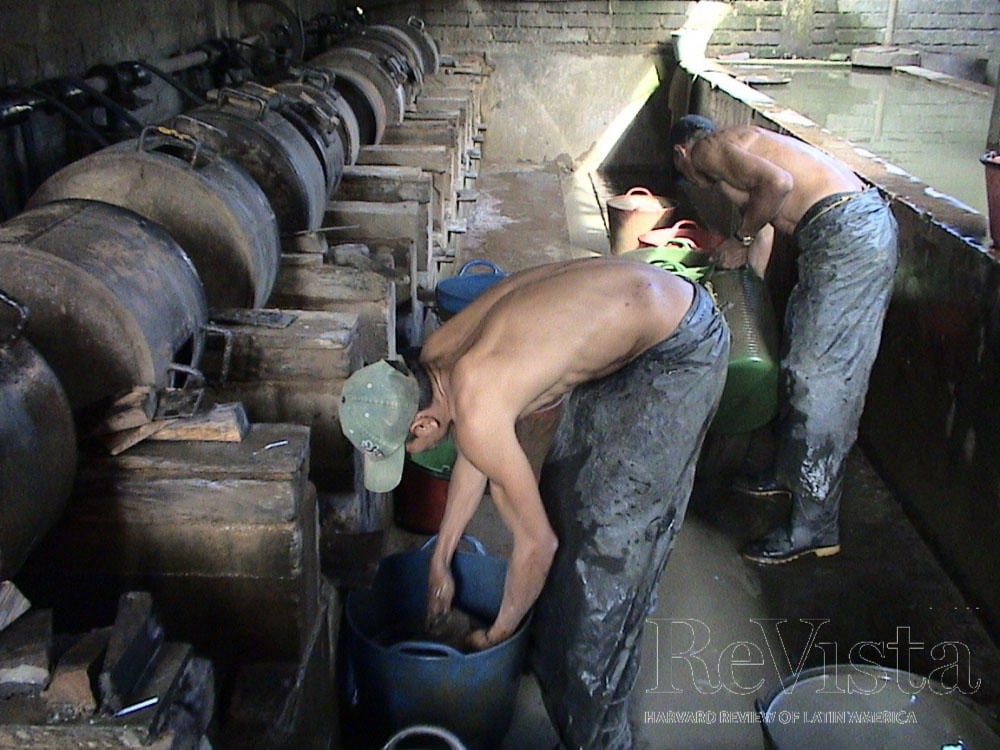Health Impact of Artisanal Gold Mining in Latin America
A Mining Boom Brings Risk from Mercury Contamination

Ball mills or “cocos” in Colombia. Almost 100 grams of mercury is added to 60 kilograms of ore in each mill. Photo by Marcello Veiga
Metallurgy in Latin America dates back more than 4,000 years. Ancient artifacts of gold have been found at numerous sites throughout the Andes. The colonial era brought expanded mining of gold, silver and other metals. Techniques to increase the yield of precious metals were introduced, including use of environmentally hazardous processes such as mercury amalgamation. To this day mining continues as an important sector of the economy. However, the gold boom of the past decade has highlighted the risks and benefits of its expansion. The health effects of mining are one important concern.
Latin America contains some of the world’s largest deposits of gold and other precious metals, such as Gramalote and La Colosa in Colombia, Pueblo Viejo in the Dominican Republic, Madre de Dios in Peru, and the Volta Grande in Brazil. As these countries experience growth, they must decide what role mining should play in their futures. Recovering valuable metals can make these nations more prosperous, thereby improving the health and well-being of their citizens. However, mining, particularly small-scale artisanal mining, also brings toxic exposures that produce adverse health effects on local and distant populations.
The impact of gold mining depends on the location of the metal and the methods used to extract it. Gold was first found in alluvial deposits, where the shiny flakes or nuggets appeared among loose rocks and silt that were deposited in shoals or “placers” by moving water. For centuries this was the easiest way to find and recover gold, and placer mining remains widespread today. To extract the gold, miners create a slurry of the loose material from alluvial deposits and water, and then collect the relatively dense gold in pans, known as “bateas,” or in more sophisticated sluices or mats that trap the gold particles. The concentration of gold in alluvial deposits is usually low—sometimes 1:1 million. Once the gold-containing particles have been separated from the rest of the sediment, mercury is added to further purify it. The mercury binds the gold to form an amalgam and is later removed, leaving the gold behind and often releasing mercury into the environment.
Large-scale heavy rock mining began in the mid-1800s as gold-rush entrepreneurs brought capital, labor, and equipment to mine the veins from which the placer deposits originated. Most gold mined today comes from large industrial operations, either in open pits or underground mines. Gold recovery requires heavy equipment and abundant water, and often leads to the destruction of local farmland and habitats.
Gold in hard rock is chemically bound to the ground rock. In industrial operations, gold is released by crushing the ore into a fine powder, then mixing it with sodium cyanide to bind to the gold to separate it. The cyanidation process, currently used in 90 percent of gold production, remains controversial due to the toxic nature of cyanide. However, unlike mercury, cyanide is degradable and does not accumulate in animals as it moves through the food chain. In Latin America, most artisanal miners do hard rock mining, primarily in small underground mines that they operate themselves or industrial mines that have been abandoned. Hard rock artisanal miners are more likely to use mercury than cyanide to harvest their gold.
Both artisanal and industrial mining flourish in Latin America, each with its own consequences for the environment and human health. Within this region, artisanal miners produce 200,000 kilograms of gold per year; nearly 40 percent of the gold that originates there. Most artisanal mining is illegal and unregulated. This work provides a livelihood for nearly two million people—about nine miners and support workers are needed to produce each kilogram of gold—but at an environmental cost that exceeds this benefit.
The major health risk from artisanal mining is mercury. Worldwide, artisanal mining is estimated to emit at least 1,400 metric tons per year. Of this about two thirds are released locally into soil and water near mining operations, and a third is released into the atmosphere, where it has the potential to affect people far from the mining sites. Artisanal mining is the largest single source of atmospheric mercury, accounting for 37 percent of annual emissions. Coal burning accounts for another 24 percent .
In placer mining, mercury is added to the material extracted from the alluvial deposits. Excess mercury is usually washed into the adjacent waterways along with other tailings, where it enters the local ecosystem. As mercury moves through the aquatic food chain, it becomes an even greater threat to health. The elemental “quicksilver” form of mercury that is used to create amalgam is relatively inert. However, in aquatic environments it is taken up by bacteria and algae, and is converted into the far more dangerous methyl mercury. Methyl mercury travels up the food chain, from algae to plankton to small fish to big fish, becoming progressively more concentrated. When consumed by humans, methyl mercury in fish is absorbed through the gastrointestinal system. Mercury can enter the brain and cross the placenta. It remains in the body bound to proteins, making it difficult to eliminate. The effects of methyl mercury on the developing fetus were tragically demonstrated in Minamata, Japan. Children born to mothers who consumed mercury-contaminated fish suffered devastating birth defects, particularly those affecting the nervous system. Children and adults who consumed contaminated fish also suffered neurologic damage and autoimmune disorders.
Mercury is used in small-scale hard rock mining operations. It is added to the crushed ore in small ball mills called “cocos.” The mills contain steel balls that crush the ore and mix it with mercury. The amalgam is collected, but about half of the mercury remains mixed with the crushed ore and is usually discarded.
Mercury vapor is produced when miners “roast” the amalgam, releasing the mercury and leaving the gold behind. Amalgam, which is 40 to 50 percent mercury by weight, is often roasted in the shops where miners sell their gold. For security reasons, the shops are often located in towns, where this dangerous vaporized mercury affects the inhabitants. Safety equipment, such as simple kitchen bowl retorts that trap fumes during the roasting process, are rarely used. While elemental mercury is poorly absorbed by the gastrointestinal tract, inhalation of its vapor gives it increased access to the brain and other systems. Mercury can impair vision, hearing, and balance, and sometimes causes coma or death. Damage to the kidneys often requires dialysis or even kidney transplants. Of particular concern is the tradition that the work of roasting amalgam is best done by women, many of whom have children with them or are pregnant.
The impact of mercury from artisanal mining in Colombia was well documented by the United Nations Industrial Development Organization Mercury Project led by Marcello Veiga. Veiga assessed mercury contamination in five towns in the Department of Antioquia. He found the worst mercury pollution ever recorded, with mercury levels more than 1,000 times higher than the World Health Organization limits. Studies by the University of Antioquia have shown numerous cases of acute mercury poisoning, and evidence of chronic mercury toxicity in a many of the local children. They had decreases in attention, language, memory, and executive function. Similar health impacts exist in other South American boom towns, such as Puerto Maldonaldo in Peru.
Despite the well known health consequences from mercury in gold mining, the amalgamation process persists among small-scale miners in Latin America and globally. Mercury remains cheap and readily available. No special equipment is needed for its use in amalgamation, so it is easy for miners to move from one location to another and seek out richer deposits or evade arrest for this illegal activity. Artisanal gold mining with mercury nearly disappeared in the mid-20th century, displaced by more efficient large-scale mining operations that use cyanide. However, the rise in gold prices, coupled with political and socio-economic instability in some areas in the 1970s, made gold mining appealing again to poor operators who could not afford more modern technology. This past decade’s boom in gold prices piqued the interest of both artisanal and industrial mining operations. However, the slump in prices over the past year has caused some mining companies to scale back their ambitions, while the more nimble artisanal miners, with their lower overhead and ease of evading environmental and labor laws, continue to thrive.
Artisanal miners will continue to use mercury as long as they believe that the benefits of this method outweigh the costs. Shifts in attitudes must come from making miners aware of the risks and showing them new techniques that minimize the amount of mercury used or replace mercury amalgamation with safer alternatives. Workers and their families will benefit, as will everyone on the planet, since most mercury in the atmosphere is eventually deposited in the oceans, where it contributes to global methyl mercury contamination of seafood.
Restriction of mercury trade by the recent Minamata Convention, as well as national regulations, are intended to decrease the availability of the metal. As mercury becomes harder to come by, it is hoped that miners will seek safer alternatives. Governments, universities, and non-governmental organizations can promote this transition.
Winter 2014, Volume XIII, Number 2
Nancy Long Sieber is an Adjunct Lecturer in the Department of Environmental Health at Harvard School of Public Health. She has a broad interest in global and environmental health, especially metal toxicity.
Joseph Brain is the Drinker Professor of Environmental Physiology at the Harvard School of Public Health. His research emphasizes inhalation toxicology with a particular interest in metals.
Related Articles
Making a Difference: Building Blocks
Since the first, unplanned visit of a Brazilian entrepreneur in 2011 to Harvard’s Center on the Developing Child, a diverse group of professors, practitioners, civil society leaders and other committed individuals at Harvard and in Brazil have…
Travails of a Miner, VIP-style
English + Español
Sergio Sepúlveda is a Chilean miner with an enviable salary—equivalent to that earned by a university-educated professional. He owns a brand new Korean-made car, and every three years…
Indigenous People and Resistance to Mining Projects
English + Español
Latin America’s governments and its indigenous peoples are clashing over the issue of mining. Governments, motivated by economic growth, have established legal frameworks to attract foreign investments to extract mining resources. When those resources are located in…




